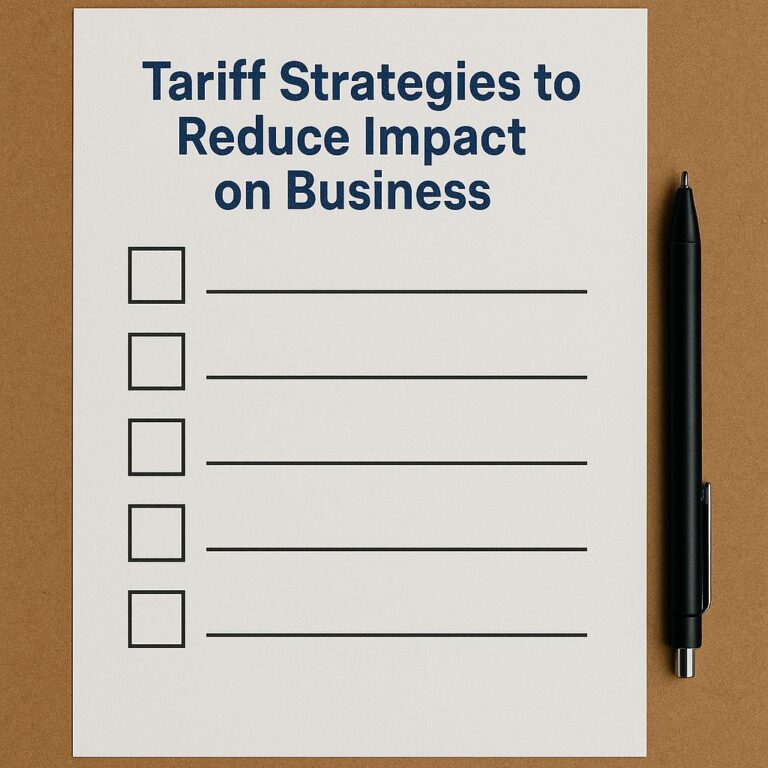
From bonded warehouses to first sale pricing, can these tariff strategies revealed by experts and Amazon sellers keep operations running strong?
Trump tariffs are intensifying, stirring concern among importers, Amazon sellers, and manufacturers. With the potential for new duties, businesses are bracing for fresh disruptions in already strained supply chains.
California has launched a legal challenge, calling the administration’s tariff powers illegal and unconstitutional. Small businesses have followed suit, arguing the tariffs from President Trump were imposed without proper authority and are damaging their operations.
While court decisions may reshape tariff enforcement, sellers can’t afford to stand still. Strategic tariff planning, like bonded warehousing, first sale valuation, and supply chain shifts, is critical to staying resilient in an unpredictable trade environment.
Tariff strategies to address impacts of trade policy shifts
The U.S. government’s renewed emphasis on tariffs under the “America First” agenda is creating ripple effects across global trade. According to a Morgan Lewis article, this strategy, justified under national security grounds, is driving uncertainty for businesses and trade partners alike.
As executive authority becomes a key tool in tariff enforcement, legal battles are mounting over its legitimacy. Businesses now face an unpredictable regulatory environment and must adapt quickly to stay competitive.
Morgan Lewis outlines practical steps companies can take to safeguard operations and manage rising trade risks.
(1) Diversifying the supply chain to minimize tariff exposure in 2025
To reduce risks from shifting trade policies, businesses must turn to supply chain diversification as a core strategy for navigating tariff challenges . According to Supply Chain Management Review, this approach enhances both flexibility and long-term resilience.
Reshoring and nearshoring, or bringing production closer to U.S. markets, helps companies limit exposure to foreign tariffs. Though this move requires upfront investment, it improves lead times, operational oversight, and cost control over time.
Heavy dependence on a single region for sourcing leaves companies vulnerable to sudden tariff spikes. By spreading sourcing across multiple countries, businesses gain agility and reduce risk.
Another tactic, known as tariff engineering, involves adjusting product designs or material sources to reduce duty costs. Work with trade professionals to ensure compliance while reconfiguring products for cost efficiency.
Umbrex"Reduce vulnerability to supply chain disruptions by spreading risk across multiple suppliers and regions."
(2) Strengthening contracts for navigating tariff shocks
Contract management has emerged as a key line of defense for companies adjusting to new tariff realities. Following the sweeping 10% tariff under Executive Order 14098, businesses are reassessing how agreements can protect them from sudden cost spikes, Harvard Business Review reports.
To adapt, firms may enhance their contracts with updated force majeure clauses and built-in price adjustment mechanisms. These changes allow greater flexibility in responding to trade disruptions and cost fluctuations.
Contractual terms are also being used to support sourcing diversification and clarify cost responsibilities across the supply chain. Stronger, more transparent agreements help businesses stay resilient under pressure from unpredictable tariff measures.
Top sellers share tactical tariff strategies at BDSS XI
At the BDSS XI summit in Iceland, industry leaders offered Amazon sellers practical strategies for navigating the impact of tariffs. The insights came from seasoned operators during the S.M.A.R.T. competition, including Rob Hahn of Pattern, Bernie Thompson, and Brandon Young. Kevin King’s LinkedIn newsletter provided a recap of the event.
(3) Strategic clarity over panic
Rob Hahn, COO at Pattern, urged sellers to remain level-headed and avoid knee-jerk reactions. He clarified that tariffs stem from trade deficits, not retaliation, and primarily affect manufacturing, not retail costs.
Hahn advised sellers to slow down, review their inventory positions, and consider holding stock to increase its value amid market uncertainty. He also encouraged exploring international expansion and supply chain redundancy through near-shoring or reshoring.
Steven Pope, founder of our Amazon agency , advises sellers to move their manufacturing operations out of China.
As new tariffs loom and uncertainty builds, Amazon sellers are rethinking their sourcing and inventory decisions. According to Pope, the answer to whether you should complete your next China order is likely “no.”
Here’s why Pope advises against it:
Margins are rapidly shrinking due to rising tariffs.
Most sellers can’t make their China-based products profitable at current rates.
There are short-term alternatives and workarounds—if you act strategically.
Options to consider:
Renegotiate with your China supplier. Some manufacturers may be open to covering tariffs or import duties to keep your business.
Pause reorders temporarily. Even going out of stock may be safer than importing unprofitable goods.
Shift sourcing. Countries like Vietnam and India are becoming more viable options, especially for certain product types.
When going out of stock might be smarter
Pope, known for advising sellers to never run out of stock, now offers a rare exception.
“Going out of stock might be safer than destroying your margins,” he says.
If forced to choose between two poor options, it may be better to lose some ranking than pay inflated costs.
Just-in-time inventory models have already failed many sellers. Pope has long advocated for a 12-month inventory buffer, and those who followed that advice are now in a better position to ride out sourcing disruptions.
(4) Import tariff deferral as a cash flow buffer
Bernie Thompson highlighted the massive cost jump his brand faced—tariff duties rising from $35,000 to $2.3 million overnight. To manage this, he recommended using bonded warehouses to defer duties.
According to Rogers & Brown, a leader in international logistics, bonded warehouses serve as a critical tool for companies seeking tariff strategies that balance cost and supply chain efficiency.
In an evolving trade landscape, bonded warehouses are emerging as a smart tool for managing tariff exposure. These customs-approved storage facilities allow businesses to defer duty payments until goods enter the U.S. market, providing flexibility during periods of uncertainty.
Key advantages of bonded warehousing
Deferred duty payments – Importers store goods without immediately paying duties or taxes.
Cash flow optimization – Tariff costs are delayed until the products are released for sale.
Protection from tariff surges – Delaying payment shields businesses from sudden increases in duties.
Inventory flexibility – Goods can be released in phases, allowing businesses to respond to shifting demand without overcommitting capital.
This structure helps importers navigate unpredictable market conditions, offering room for better financial planning and efficient inventory control.
By staggering the release of inventory, companies avoid front-loading costs and can better align tariff payments with actual sales. This reduces financial strain, especially for seasonal or slower-moving goods.
(5) Leverage first sale doctrine
Brandon Young presented a detailed approach to reducing tariff burdens through the “first sale doctrine.” This method calculates duties based on the original cost of goods, not inflated prices passed through intermediaries.
Cozen O'Connor"The first sale doctrine is an important principle in U.S. customs law that allows importers to use the price of the first sale in a series of transactions as the basis for calculating customs duties."
He emphasized documenting every product component’s cost: tooling, content, branding, and software, to separate non-dutiable elements. By doing so, sellers could legally lower their dutiable amounts and significantly cut tariff expenses.






